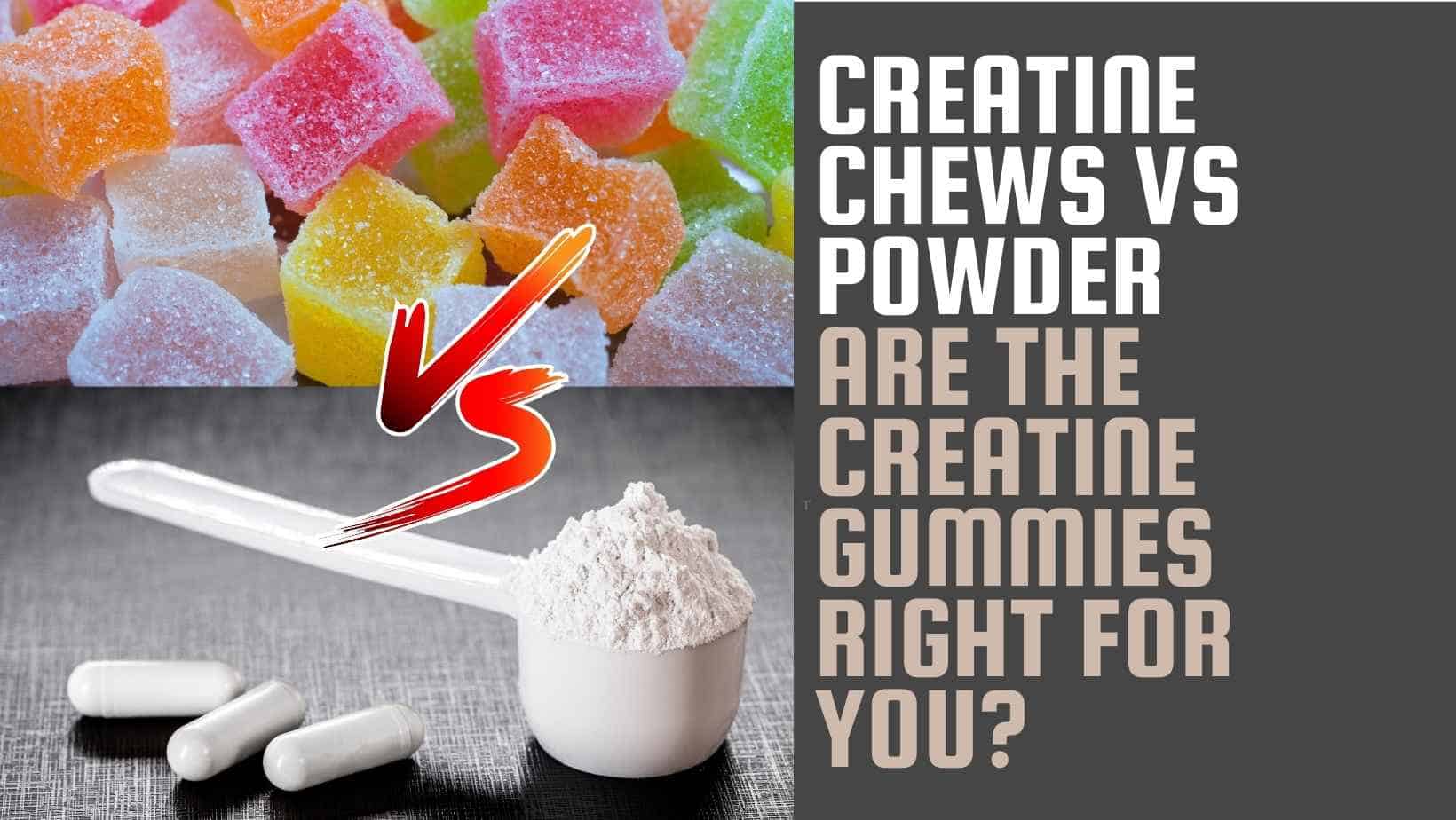Creatine Chews vs Powder: Are The Creatine Gummies Right For You?

Creatine supplements come in different forms, such as creatine chews and creatine powder.
Creatine powder has been a staple for many athletes and fitness enthusiasts due to its effectiveness and versatility.
It’s easy to mix with water or other beverages, making it a convenient choice for many.
Creatine chews, often known as creatine gummies, provide a tasty and portable alternative. They are pre-measured and ready to consume, eliminating the need for mixing.
Both forms aim to boost your workout performance and muscle growth.
When choosing between creatine powder and chews, consider factors like convenience, taste, and how you plan to incorporate them into your daily routine.
Creatine powder offers flexibility, while chews add simplicity and flavor.
Table of Contents
▶️ Creatine Supplementation Fundamentals
Understanding creatine is key to maximizing its benefits. Both chews and powder forms offer unique advantages for enhancing muscle energy and performance.
✅ Understanding Creatine and Its Role in Fitness
Creatine is a compound found naturally in muscles. It helps produce energy during high-intensity exercise.
Most of the creatine in your body is stored in muscles as phosphocreatine. When you work out, phosphocreatine helps produce ATP (adenosine triphosphate), which fuels muscle contractions.
Supplementing with creatine can improve strength, increase lean muscle mass, and help muscles recover faster during exercise.
Creatine monohydrate is the most researched and widely used form. It is safe and effective for most people looking to enhance their exercise performance.
✅ Forms of Creatine: Chews vs Powder
Creatine chews and powder are popular choices for supplementation.
Creatine powder is typically mixed with water or a sports drink. It’s absorbable and can be taken with fluids. This makes it a convenient option for many gym-goers.
Creatine chews, on the other hand, are pre-measured and easy to take on the go. They do not require mixing.
Both forms effectively boost muscle energy but offer different conveniences.
✅ Amino Acids and Muscle Energy
Amino acids are the building blocks of proteins and play a crucial role in muscle repair and growth.
Creatine works in tandem with amino acids to enhance muscle performance. While amino acids help repair muscle tissue, creatine provides the energy needed for muscle contractions.
The combination of creatine and amino acids helps sustain ATP levels during intense workouts. This means your muscles can work harder and recover faster.
Understanding this interaction is vital for maximizing your fitness gains with creatine supplementation.
▶️ Comparative Analysis of Creatine Forms
Creatine chews and powder forms differ in several ways, including how well they work, how easily they can be used, their taste, texture, and safety.
✅ Efficacy and Absorption Rates
Creatine Powder
Generally, creatine powder is rapidly absorbed when mixed with liquid.
This form allows for a quicker entry into the bloodstream, which can be beneficial for immediate effects post-workout.
Studies indicate that oral ingestion of creatine powder results in significant increases in plasma creatine levels, particularly when taken in higher doses (around 5 grams).
Creatine Gummies
While some manufacturers claim that gummies may offer improved bioavailability or faster digestion, the consensus is that absorption speed is not significantly different between the two forms.
Creatine levels build up over time in the body, making the immediate absorption less critical for overall effectiveness.
However, gummies are often considered more convenient and palatable, which may encourage consistent use.
Research suggests that the differences in absorption may be minor, meaning both forms can be effective.
Your choice might come down to how quickly you want the creatine to work and how it fits into your daily routine.
✅ Convenience and Usage Scenarios
Creatine powder requires mixing with water or another liquid. This makes it less convenient if you’re on the go.
You need to carry a shaker or mixing tool, which can be cumbersome.
Creatine chews, on the other hand, are easy to transport. You can take them at any time without needing extra equipment.
This makes them a good option for busy schedules or travel.
✅ Taste, Texture, and Personal Preference
Creatine powder is often tasteless, but it can have a gritty texture if not mixed well. Some flavored versions are available, but you might find them too sweet or artificial. Mixing the powder with juice or a smoothie can improve the taste.
Creatine chews come in various flavors, often making them more enjoyable to consume. They have a chewy texture, similar to candy, which many people prefer.
Your personal taste and texture preferences will play a big role in deciding between the two.
✅ Safety and Side Effect Profiles
Both forms of creatine are generally safe when used as directed.
Common side effects include stomach cramps and bloating.
Because creatine powder is usually mixed with a liquid, it might lead to bloating if consumed quickly.
Creatine chews might contain added sugars or other ingredients that could affect your health, especially if you have dietary restrictions.
It’s essential to check the ingredient list to avoid any unwanted substances.
▶️ Practical Aspects of Creatine Use
Taking creatine can enhance your exercise performance and muscle recovery.
The key points to consider include how to measure the right dosage, how to incorporate creatine into your daily routine, and understanding the cost of different forms of creatine.
✅ Optimizing Dosage and the Loading Phase
To start with creatine, you usually go through a loading phase.
During this time, you typically take about 20 grams per day, split into 4 servings, for 5-7 days. This rapidly increases the creatine levels in your muscles.
After the loading phase, move to a maintenance dose of around 3-5 grams per day. This helps to keep your muscle creatine levels high, improving muscle strength and recovery.
You can take creatine with water, juice, or protein shakes.
It’s essential to take the right amount to prevent stomach issues and to get the best results for muscle strength and exercise performance.
✅ Incorporating Creatine into a Supplement Routine
Adding creatine to your supplement routine is simple.
You can take it at any time of the day, but I prefer to take it pre-workout because of the benefits mentioned previously.
Mixing creatine powder into a shake or taking a creatine chew is a personal choice.
Powders mix well with other supplements, while chews are convenient and easy to consume on the go.
Make sure you drink enough water throughout the day when taking creatine. Proper hydration aids in its absorption, benefiting your muscles and exercise performance.
✅ Cost and Availability Considerations
Creatine comes in various forms, including chews and powders.
Creatine powder is often cheaper and widely available. It’s sold in bulk and offers more servings per container.
Creatine chews, while more convenient, might be more expensive. They are pre-measured, which can help you stick to the right dosage.
When shopping for creatine, check the price per serving to get the best deal.
Both forms are effective, so choose based on what fits your lifestyle and budget better. You can find these products in most health stores, gyms, and online retailers.
▶️ Scientific Insights and Health Implications
Creatine is known for boosting muscle mass and strength. It also shows promise for brain health, affecting memory and cognitive function.
We’ll look at how creatine works in these areas and what research says about its long-term use.
✅ Creatine’s Impact on Muscle Mass and Strength Training
Creatine helps increase muscle mass by drawing water into muscle cells. This makes muscles look fuller and larger.
It also boosts the production of ATP, the primary energy carrier in cells.
When you lift weights or do high-intensity exercise, your muscles use ATP quickly.
Creatine helps replenish ATP levels, improving your ability to perform short bursts of intense activity.
Studies have shown that creatine supplementation can significantly improve strength training outcomes, making it a popular choice among athletes.
✅ Beyond Muscles: Creatine and Brain Health
Creatine isn’t just for muscles. It plays a role in brain health by supplying energy to brain cells.
This can be particularly important as you age, given the increased energy demands of the brain.
Research indicates that creatine can boost memory and cognitive function, potentially delaying cognitive decline.
Some studies even suggest it might help alleviate symptoms of depression. For people involved in tasks requiring quick thinking and problem-solving, creatine might offer a slight edge.
✅ Assessing the Research on Long-Term Effects
When considering long-term usage, it’s essential to look at what the science says.
Most studies focus on short-term benefits, but research on long-term use shows varied results.
There are no significant negative impacts reported in healthy adults.
However, there is limited information on its effects over many years.
Current data suggests that ongoing supplementation may support lean body mass and energy production without major side effects.
Always consult a healthcare provider before starting any new supplement regimen.
Creatine offers multiple benefits, from enhancing muscle mass to possibly improving brain health and cognitive function.
While long-term studies are still in development, current evidence supports its safety and effectiveness for many users.
▶️ Use Of Creatine Misconceptions
There are several common misconceptions about creatine that have been debunked by scientific evidence:
❓Myth: Creatine causes water retention and bloating
Reality: While creatine is an osmotically active substance that can pull water into muscles, this does not necessarily lead to significant water retention or bloating. Proper hydration is important when taking creatine, but excessive water intake is not needed
❓Myth: Creatine is an anabolic steroid
Reality: Creatine has a completely different chemical structure compared to anabolic steroids, which are synthetic testosterone derivatives. Creatine is a natural substance found in the body and foods.
❓Myth: Creatine causes kidney damage
Reality: After over 30 years of research, there is no evidence that creatine supplementation causes kidney damage or dysfunction in healthy individuals when taken at recommended doses. The increase in creatinine levels is due to normal creatine metabolism.
❓Myth: Creatine causes hair loss or baldness
Reality: Current evidence does not indicate that creatine increases testosterone, DHT, or causes hair loss.
❓Myth: Creatine leads to dehydration and cramping
Reality: Creatine does not cause dehydration or muscle cramping. It may actually have protective effects against these issues.
❓Myth: A loading phase is required for creatine
Reality: While a loading phase can saturate muscle creatine stores faster, it is not necessary. Lower daily doses of 3-5g are effective for increasing muscle creatine over time.
In summary, creatine is a safe and effective supplement when taken at recommended doses, with no evidence supporting many of the common misconceptions about its side effects. Creatine monohydrate remains the most extensively studied and effective form of creatine.
▶️ Conclusion
Let’s wrap this up with the key things you should remember about creatine chews vs powder.
First off, both forms can give your workouts a serious boost. They’re great for improving strength, building muscle, and helping you recover faster. The choice really comes down to what works best for you.
If you’re always on the go, those creatine chews might be your new best friend. They’re pre-measured, portable, and hey, they actually taste good! No need to lug around a shaker bottle or worry about mixing.
But don’t count out the classic creatine powder. It’s usually cheaper, mixes well with your favorite drinks, and gives you more flexibility with dosing. Plus, it’s been the go-to for athletes for years.
Now, here’s what you can do:
1. Start with a loading phase if you want quick results. Take about 20 grams a day, split into 4 servings, for 5-7 days. But don’t sweat it if you prefer to skip this – you can still get benefits with a lower daily dose over time.
2. After loading (or right from the start if you skip loading), stick to 3-5 grams a day. That’s your maintenance dose to keep those muscles happy.
3. Timing isn’t super critical. Take it when it’s convenient for you, though many people like taking it after their workout.
4. Stay hydrated! Drink plenty of water throughout the day when you’re supplementing with creatine.
5. If you’re curious about the brain benefits, keep an eye out for more research. Early studies show some promising cognitive perks!
Remember, while creatine is generally safe, it’s always smart to chat with your doctor before starting any new supplement routine.
So, whether you go for the chews or the powder, you’re on track to amp up your fitness game. Pick the form that fits your lifestyle, stick to the recommended dosage, and get ready to crush those workouts!
▶️ References
https://jissn.biomedcentral.com/articles/10.1186/s12970-021-00412-w
https://nutrabay.com/magazine/common-creatine-myths-explained
https://www.ncbi.nlm.nih.gov/pmc/articles/PMC8912867/
https://www.optimumnutrition.co.in/blog/dispelling-common-myths-and-misconceptions-about-creatine
https://pubmed.ncbi.nlm.nih.gov/33557850/
https://creatineforhealth.com/common-questions-and-misconceptions-about-creatine-supplementation/
https://www.sci-sport.com/en/articles/Creatine-and-its-myths-what-does-science-have-to-say-243.php
https://us.myprotein.com/thezone/supplements/creatine-pills-vs-powder-which-better/






